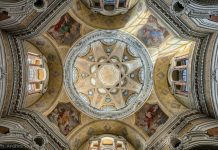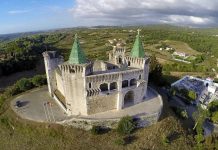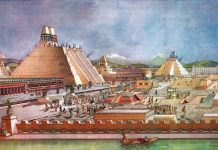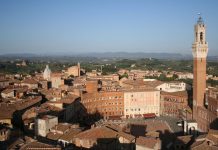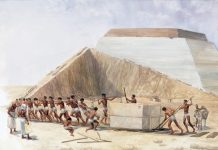Not so far from Mesopotamia, in North Africa, at about the same time, another great civilization appeared – the ancient Egyptian. It is also marked by the construction of grandiose structures very similar to ziggurats – pyramids, but, unlike Mesopotamian analogues, the material here was more often not raw brick, but stone. The earliest of these buildings were also stepped: Egyptian architects did not immediately find the ideal shape with smooth edges, so close to the modernist tastes of the XX century. The main thing is that not only the shape and material, but also the meaning of these artificial mountains towering in the sands of Egypt, was completely different from the giant buildings of Mesopotamia.
The pyramid is, first of all, a tombstone monument. Actually, the idea of the composition tapering upwards was born in Egypt, when several flat stone tombs were placed on top of one another (the Arabs – now the main population of this country – call them “mastaba”, that is, “bench”). Such tombs, hiding burial chambers, were built in the deserts along the banks of the Nile long before the appearance of huge stone structures, so the pyramid, as it turned out by Egyptian architects, despite its external similarity and impressive size, can hardly be considered a man-made World Mountain, although it is, of course, connected with the sky. At least, its faces, as a rule, are quite accurately oriented to the cardinal directions, and one of the inclined internal corridors is parallel to the earth’s axis. There is even a bold hypothesis according to which the pyramids at Giza are mirrored in the same way as the stars of the Orion belt. It turns out that the Egyptians did not have time to build at least four more large pyramids to fully reproduce this beautiful constellation.
But still, the main theme of ancient Egyptian architecture is not the sky, but the afterlife. The Egyptians took their fate after death very seriously. At the moment of passing away, a person seemed to be sorted into its component parts: spirit and soul, shadow and physical body, name and power… Pharaoh and his entourage were also supposed to have a spiritual double – Ka, the rest were just a soul – Ba. In order to reconnect with the rest of the parts, the soul alone had to go through numerous trials on a journey through the afterlife, and then appear before the court of the terrible Osiris and prove that its owner had not committed any of the 42 sinful acts.
On special scales, the gods weighed the heart of the deceased. If, burdened with sins, it outweighed the feather from the headdress of the goddess Maat, personifying the truth, then it went into the mouth of a terrible crocodile, which deprived the former owner of the chances of rebirth. The acquitted person by the court reunited all his parts in himself and went to the land of eternal bliss in a complete set. Do not think that the theme of death made ancient Egyptian art somehow gloomy. Leaving life was perceived simply as relocation and continuation of existence in other conditions, and not as a terrible end. The deceased, however, had to go through severe trials, but even in our time, moving is equated to a natural disaster. By the way, the famous “Book of the Dead” (the ancient Egyptian guide to afterlife travel) received this frightening name from the Arabs who excavated ancient tombs. The Egyptians themselves called it “Er nu peret em heru” – “Sayings of a day out.”
The other world in the ideas of the ancient Egyptians was always present next to them, as if right there, only in another dimension. However, there were few points of contact between the two worlds – the earthly and the afterlife. And where such points were found, sacred cities and, consequently, temples were built. Like the pyramids, temples have become the face of Egyptian architecture. However, we should not forget that there is a whole time gap between the two types of buildings – about a thousand years.





